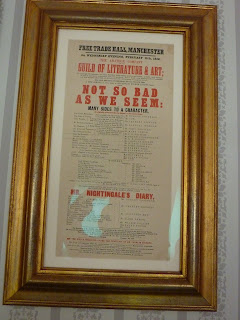A day trip to London, this time for Alison to go to the Pompeii exhibition at the British Museum. But I had other plans. The day started bright, sunny and mild. We didn't have to bother with coats. We took the train from Stoke Mandeville and split up after we reached Holborn on the Underground. I walked to Doughty Street for the Dickens Museum.
Number 48 Doughty Street was an important place in Charles Dickens's life where he resided from 1837 until 1839. Dickens described the terraced Georgian dwelling as 'my house in town'.
Two of his daughters were born here, his sister-in-law Mary died aged 17 in an upstairs bedroom and some of Dickens’s best-loved novels were written here, including Oliver Twist and Nicholas Nickleby. However Dickens required more space for his growing family and moved to 1 Devonshire Terrace in 1839. The house remained a residential property, but was threatened with demolition in 1923, when the Dickens Fellowship acquired it. The Museum was opened in 1925 and has become the home of the world’s finest Dickens-related collection.
The Museum is a registered charity (No. 212127) and governed by an independent Trust.
I was quite impressed by the layout of the rooms and the content of the exhibits.
You can just imagine Dickens sitting down to dinner with friends in the tasteful Dining Room.
The most interesting piece on display was the above poster for a production by Charles Dickens at the Free Trade Hall, Manchester on Wednesday Evening 11th February 1852 by The Amateur Company: Guild of Literature and Art. He appears as the second main character in "Not So Bad We Seem" and also plays a part in a farce he wrote with Mr Mark Lenon called "Mr Nightingale's Diary". So not only a prolific writer, but a producer, director and actor.
Having read some of the Pickwick Papers for Book Club, I knew they, and most of his works, were originally published in pamphlets in monthly instalments. I asked one of the staff if there were any of the original pamphlets on display and he showed me Volume V1 of "The Mystery of Edwin Drood" published in September 1870 for eighteen pence. Apparently there could have been 20 instalments which would make the whole book cost £1.50. Quite a sum for those days.
After a welcome cup of tea and a piece of cake in the cafe, I headed back to Holborn for the Underground to Bank and the short walk to Leadenhall Market, somewhere that I had never been. It was lunchtime and packed with city workers enjoying a drink on a warm sunny day or eating in the cafes.
The restoration and redecoration of the market has made this a superb building, originally dating from the 14th century. No wonder it was the inspiration for Diagon Alley. One thing that the Dickens Museum and Leadenhall Market have in common is that they both appear in the movie "Hereafter". I guess that is what inspired my visit. I couldn't make the other location, Alexandra Palace.
Wherever I go, there seems to be musicians.
I thought the following photo was interesting, the modern Lloyd's Building peeping through an entrance to the market.
It was time to join up with Alison at the British Museum. We had a drink and shared a huge scone before making the most of what was like a summer's day. Regents Park was splendid in the sunshine.









No comments:
Post a Comment